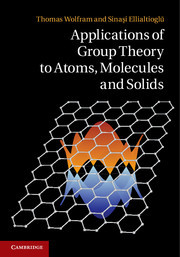Description
Applications of Group Theory to Atoms, Molecules, and Solids
Authors: Wolfram Thomas, Ellialtıoğlu Şinasi
An applications-oriented approach gives graduate students and researchers in the physical sciences the tools needed to analyze any physical system.
Language: English
Subject for Applications of Group Theory to Atoms, Molecules, and Solids:
190.51 €
In Print (Delivery period: 14 days).
Add to cart
Publication date: 01-2014
481 p. · 17.7x25.4 cm · Hardback
481 p. · 17.7x25.4 cm · Hardback
Description
/li>Contents
/li>Biography
/li>
The majority of all knowledge concerning atoms, molecules, and solids has been derived from applications of group theory. Taking a unique, applications-oriented approach, this book gives readers the tools needed to analyze any atomic, molecular, or crystalline solid system. Using a clearly defined, eight-step program, this book helps readers to understand the power of group theory, what information can be obtained from it, and how to obtain it. The book takes in modern topics, such as graphene, carbon nanotubes and isotopic frequencies of molecules, as well as more traditional subjects: the vibrational and electronic states of molecules and solids, crystal field and ligand field theory, transition metal complexes, space groups, time reversal symmetry, and magnetic groups. With over 100 end-of-chapter exercises, this book is invaluable for graduate students and researchers in physics, chemistry, electrical engineering and materials science.
Preface; 1. Introductory example: squarene; 2. Molecular vibrations of isotopically substituted AB2 molecules; 3. Spherical symmetry and the full rotation group; 4. Crystal field theory; 5. Electron spin and angular momentum; 6. Molecular electronic structure: the LCAO model; 7. Electronic states of diatomic molecules; 8. Transition metal complexes; 9. Space groups and crystalline solids; 10. Application of space group theory: energy bands for the perovskite structure; 11. Applications of space group theory: lattice vibrations; 12. Time reversal and magnetic groups; 13. Graphene; 14. Carbon nanotubes; Appendixes; Index.
Thomas Wolfram is a former Chairman and Professor of the Department of Physics and Astronomy, University of Missouri, Columbia. He has founded a science and technology laboratory for a major company and started a company that manufactured diode-pumped, fiber-optic transmitters and amplifiers.
Şinasi Ellialtioğlu is a Professor and Director of Basic Sciences at TED University, Ankara, Turkey. He has served as the National Administrator of NATO Science Fellowships and chaired the Department of Physics at Middle East Technical University, Turkey.
Şinasi Ellialtioğlu is a Professor and Director of Basic Sciences at TED University, Ankara, Turkey. He has served as the National Administrator of NATO Science Fellowships and chaired the Department of Physics at Middle East Technical University, Turkey.
© 2024 LAVOISIER S.A.S.
These books may interest you

Understanding Solid State Physics 117.69 €

Understanding Solid State Physics 293.12 €


